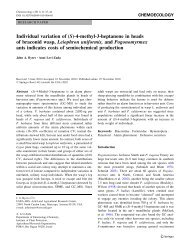EFFECTIVE ATTRACTION RADIUS: A Method ... - Chemical Ecology
EFFECTIVE ATTRACTION RADIUS: A Method ... - Chemical Ecology
EFFECTIVE ATTRACTION RADIUS: A Method ... - Chemical Ecology
Create successful ePaper yourself
Turn your PDF publications into a flip-book with our unique Google optimized e-Paper software.
762 BYERS ET AL.<br />
EARs were calculated at 10 heights for T. piniperda attraction to monoterpenes<br />
released equivalent to a "small log" (28 cm x 13 cm diam.; Byers et<br />
al., 1985) and for L typographus attraction to "medium" levels (Schlyter et<br />
al., 1987) of pheromone (Figure 3). However, these estimates at different<br />
heights may have been greatly influenced by semiochemical interactions between<br />
traps. It would be interesting to test only one pair of traps alone at each of the<br />
levels to see how this affects the EARs. The EAR estimates for T. piniperda<br />
appear similar to those that can be obtained from the data of Byers et al. (1985)<br />
for a small log (EAR = 0.59 m) or a 30 male + 30 female infested log (EAR<br />
= 0.65 m) or small log-equivalent in monoterpene release (EAR = 0.91 m)<br />
and check log (EAR = 1.02 m) at 1.5 m height.<br />
Our EAR estimates for L typographus were probably affected by the higher<br />
than usual wind speeds in the clear-cut (Figure 3, Table 1). Schlyter et al.<br />
(1987) compared a "high" dose (10 X "medium") of L typographus pheromone<br />
to a blank, 12 m away at 1.5-m height, and so we can calculate an EAR<br />
of 1.90 m, and for their "medium" dose an EAR of 0.57 m. If the blank had<br />
been placed further away, so as not to intercept any pheromone-responding<br />
beetles, then the EAR estimate would have been higher and more appropriate.<br />
Thus, as expected, higher release rates of pheromone have higher EARs. Similar<br />
procedures can be used to calculate EARs on previous work that used sticky<br />
traps. For example, Byrne et al. (1974) used sticky traps to catch 6724 Gnathotrichus<br />
sulcatus on two sulcatol-baited traps (each releasing 48-240/zg/day)<br />
versus 51 on two control traps (0.0954 m 2 interception area), which yields an<br />
EAR of 2.00 m.<br />
An EAR can be calculated for any semiochemical and responding insect<br />
species if the passive trap effectively "filters" the flying population according<br />
to the trap's size (sticky traps). However, the attractive trap, while not needing<br />
to be of the same type or dimension as the passive trap, does need to (1) effectively<br />
catch a significant proportion of the insects responding and (2) be similar<br />
or smaller in size than the passive trap in order to obtain consistent EARs for a<br />
particular chemical-insect combination. The trapping efficiencies (percentage<br />
of beetles contacting the trap that are caught) of the passive and attractive traps<br />
within a test pair would not affect the EAR, as long as the efficiencies were<br />
similar. The efficiencies could even be different on different occasions and not<br />
change the EAR unless the efficiencies change disproportionately between the<br />
passive and attractive traps.<br />
Trap size does effect trapping efficiency since Tilden et al. (1979) showed<br />
that many more D. brevicomis were attracted to the vicinity of a pheromone<br />
source and small surrounding trap than were caught on this trap. EAR estimates<br />
obtained by increasing the passive and attractive trap radius would tend to<br />
increase as a function of the trapping efficiency (size) of the attractive trap





